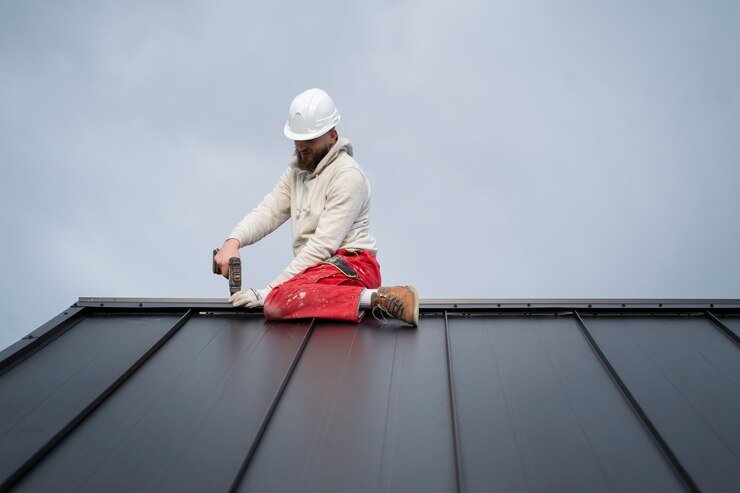Roof installation is a complex and potentially dangerous task that requires careful attention to safety at every step. Roofing companies face various risks when working at heights, handling heavy materials, and using specialized equipment. For these reasons, they must implement strict safety protocols to protect their workers and the property they are working on. We will explore how Dahlonega Roofing contractor ensure safety during projects, focusing on risk assessment, training, equipment, safety protocols, and regulatory compliance. By understanding these safety measures, homeowners and roofing professionals can minimize the risks associated with roofing installations.
Comprehensive Risk Assessment
Before starting any roofing project, a thorough risk assessment is critical in ensuring safety. Roof installation companies conduct detailed worksite evaluations to identify potential hazards. This process involves checking the roof’s condition, reviewing the structural integrity of the building, and considering environmental factors like weather conditions. During the risk assessment, companies also consider other risks, such as the roof’s weight capacity, the type of materials being used, and whether any electrical wiring or other utilities might be involved. By addressing these risks before the project begins, roofers can implement appropriate measures to prevent accidents. Identifying these hazards early helps prevent unexpected problems during the installation process and minimizes the property’s likelihood of injury or damage.
Proper Training and Certification
Roof installation requires skilled workers who understand the importance of safety on the job. Many roofing companies ensure that their employees undergo proper training and certification before they are allowed to work on roofs. This training often includes courses on the proper use of equipment, fall protection techniques, and first aid. Workers are also educated about safe work practices and the potential hazards they may face on the job. Regular safety training updates are also provided to keep workers informed about the latest safety protocols and industry standards. In addition, workers may be required to obtain certifications demonstrating their proficiency in safe roofing practices. These certifications ensure that employees are qualified to perform their tasks and help maintain a high standard of safety across the industry.
Use of Personal Protective Equipment (PPE)
Personal protective equipment (PPE) is a vital aspect of ensuring safety during roof installation projects. Roofers typically wear a range of PPE to protect themselves from the dangers of falling, cutting, and other potential injuries. Commonly used equipment includes helmets to protect against falling debris, harnesses and lanyards to prevent falls from heights, and gloves to prevent cuts and abrasions while handling sharp tools and materials. Non-slip footwear is also crucial for maintaining stability while working on sloped or slippery surfaces. Roof installation companies emphasize the importance of PPE and require all workers to use it at all times while on the job. Furthermore, companies regularly inspect the condition of PPE and replace worn or damaged items to ensure maximum protection for their employees.
Safety Protocols for Fall Protection
Falls are among the most significant hazards in roof installation, given the height at which workers operate. To mitigate the risk of falls, roof installation companies implement comprehensive fall protection protocols. These protocols include using fall arrest systems, guardrails, safety nets, and personal fall protection equipment such as harnesses and ropes. Before any worker can climb onto a roof, the company ensures proper fall protection systems are in place. Additionally, workers are trained to recognize dangerous situations, such as unstable roofing materials or slippery surfaces, that could lead to falls. Fall protection systems are regularly inspected to ensure they function properly, and workers are reminded to inspect their gear before use. By prioritizing fall protection, roof installation companies significantly reduce the chances of serious accidents during roofing projects.
Proper Equipment and Tool Usage
Roof installation often requires heavy equipment, power tools, and ladders, all of which pose safety risks if not used properly. Roof installation companies ensure that their workers are familiar with the safe handling and operation of these tools. Workers are trained on how to safely use roofing equipment such as nail guns, power saws, and drills, and they are provided with the proper tools for each job. The company also ensures that all equipment is inspected and maintained to avoid malfunctions during operation. For example, ladders are checked for stability before use, and power tools are tested to ensure they are in good working condition. By emphasizing the importance of proper tool usage, roof installation companies reduce the likelihood of malfunctioning or mishandled equipment accidents.
Safety is a top priority for roof installation companies, given the risks of working at heights and handling heavy materials. We have explored various measures companies take to ensure safety during roofing projects, such as conducting comprehensive risk assessments, providing proper training, using PPE, implementing fall protection protocols, ensuring proper tool usage, and adhering to weather conditions and regulatory requirements. These safety protocols protect workers and ensure that the roofing installation process runs smoothly, minimizing the risk of delays or accidents. By following these safety measures, roof installation companies play a crucial role in safeguarding both their workers and the properties they are working on.
